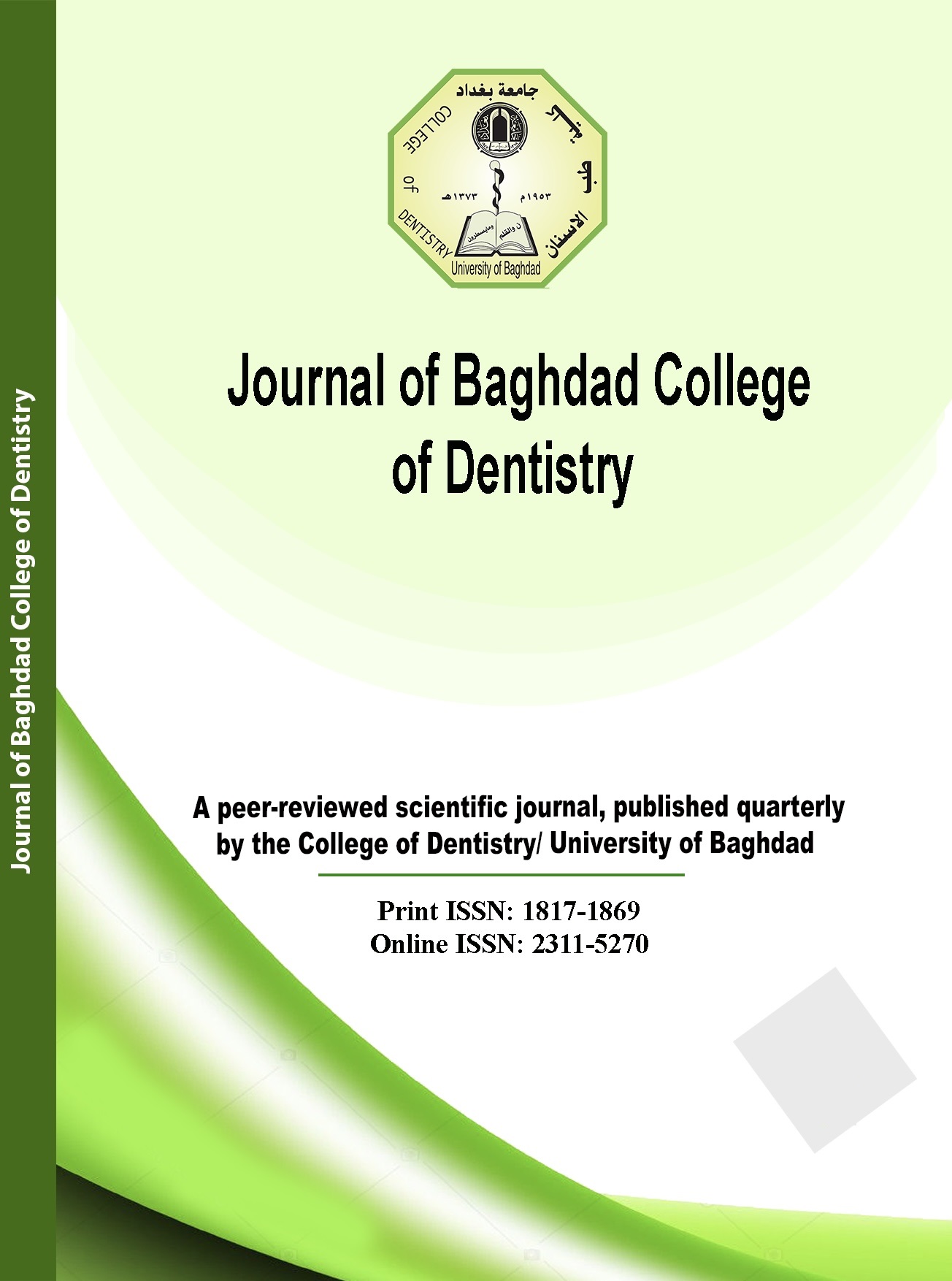Abstract
Abstract: Background: Nanoparticles in restorative materials have enhanced oral hygiene and cleanliness by increasing the quality and usefulness of dental restorations, due to small sizes, high surface-area-to-mass ratios, antimicrobial activity and strong chemical reactivity. This study aimed to evaluate the microbial leakage of laser prepared indium oxide nanoparticles added to glass ionomer filling compared to conventional glass ionomer fillings in permanent teeth. Materials and methods: Indium oxide nanoparticles were prepared using laser ablation in liquid, their properties were examined by field emission scanning electron microscopy, Ultraviolet Visible spectrophotometer and mass concentration. A predetermined amount of glass ionomer has been added to attain a homogenous content. Leakage evaluation was performed using a microbiological infiltration technique with Streptococcus mutans as an indication. Results: revealed that spherical as well as uniform nanoparticles, with particle size less than 10nm. The absorption spectra have peaks between )260-300 (nm for differently prepared samples. It was found that prolonged time for microleakage with increased nanoparticles concentration with statistically highly significant difference (P<0.001), using the Mantel–Cox log‑rank test and the Kaplan-Meier plot. Conclusion: it can be concluded that adding Indium oxide nanoparticles to glass ionomer restoration makes it more effective in preventing microbiological leakage. It was considered an alternative to conventional glass ionomer restoration.
Keywords
Dental leakage
glass ionomer restoration
indium oxide nanoparticles suspension solutions
Streptococcus mutans
Abstract
الخلفية: عززت الجسيمات النانوية في المواد التصالحية صحة الفم ونظافته من خلال زيادة جودة وفائدة حشوات الأسنان ، بسبب الأحجام الصغيرة ، وارتفاع نسبة مساحة السطح إلى الكتلة ، والنشاط المضاد للميكروبات ، والتفاعل الكيميائي القوي. الهدف من هذه الدراسة هو تقييم التسرب الميكروبي لجزيئات أكسيد الإنديوم النانوية المحضرة بالليزر المضاف إلى حشوة ال glass ionomer مقارنة بحشوات glass ionomer التقليدية في الأسنان الدائمية..
المواد وطرق العمل تم تحضير الجسيمات النانوية من أكسيد الإنديوم باستخدام الاجتثاث بالليزر في السائل ، وفحصت خصائصها بالمجهر الإلكتروني الماسح للانبعاثات الميدانية ، ومقياس الطيف الضوئي المرئي فوق البنفسجي والتركيز الكتلي. تمت إضافة حشوه ال glass ionomer بالكمية المحسوبة للحصول على تركيبة متجانسة. تم اختبار طريقة الاختراق الميكروبي باستخدام Streptococcus mutans كمؤشر لتقييم التسرب.
النتائج: أظهرت النتائج وجود جسيمات نانوية كروية ومتجانسة ، بحجم جسيمي أقل من 10 نانومتر ، كان لأطياف الامتصاص ذروتها بين (260-300) نانومتر للعينات المحضرة المختلفة. تم العثور على إطالة زمن التسرب المجهري مع زيادة تركيز الجسيمات النانوية مع وجود فروق ذات دلالة إحصائية عالية (P <0.001) ، باستخدام اختبار رتبة Mantel Cox و مخطط Kaplan-Meier
الاستنتاج: يمكن اعتبار الجسيمات النانوية المضافة من أكسيد الإنديوم إلى حشوه ال glass ionomer بمثابة مضادات للميكروبات بتسريب اقل ، وقد تم اعتباره بديلاً لحشوه ال glass ionomer التقليدية.
المواد وطرق العمل تم تحضير الجسيمات النانوية من أكسيد الإنديوم باستخدام الاجتثاث بالليزر في السائل ، وفحصت خصائصها بالمجهر الإلكتروني الماسح للانبعاثات الميدانية ، ومقياس الطيف الضوئي المرئي فوق البنفسجي والتركيز الكتلي. تمت إضافة حشوه ال glass ionomer بالكمية المحسوبة للحصول على تركيبة متجانسة. تم اختبار طريقة الاختراق الميكروبي باستخدام Streptococcus mutans كمؤشر لتقييم التسرب.
النتائج: أظهرت النتائج وجود جسيمات نانوية كروية ومتجانسة ، بحجم جسيمي أقل من 10 نانومتر ، كان لأطياف الامتصاص ذروتها بين (260-300) نانومتر للعينات المحضرة المختلفة. تم العثور على إطالة زمن التسرب المجهري مع زيادة تركيز الجسيمات النانوية مع وجود فروق ذات دلالة إحصائية عالية (P <0.001) ، باستخدام اختبار رتبة Mantel Cox و مخطط Kaplan-Meier
الاستنتاج: يمكن اعتبار الجسيمات النانوية المضافة من أكسيد الإنديوم إلى حشوه ال glass ionomer بمثابة مضادات للميكروبات بتسريب اقل ، وقد تم اعتباره بديلاً لحشوه ال glass ionomer التقليدية.
